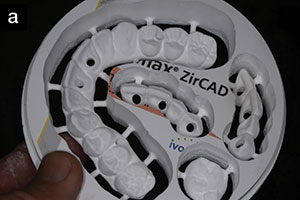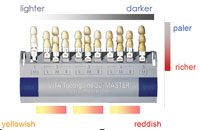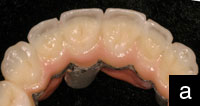Impressions must capture all the details of our preparations and be dimensionally accurate to be of optimum benefit to the dental office and dental laboratory. The quality of our preparation and final clinical result is directly reflected in the degree of accuracy of the impression. Factors such as different types of impression materials and impression trays, monophase versus dual-phase technique, cord selection and technique, and attention to moisture control can all greatly affect the accuracy and reproducibility of desired details.1
Most doctors are currently using addition reaction silicones as their impression material of choice. The majority of impressions are being taken with various brands of dual-arch (triple) trays. It is no secret that a majority of dental technicians continue to express their overall dislike of dual-arch trays. This is primarily because they are often used in nonindicated situations without recognition of the specific challenges and limitations associated with this impression technique. This leads to a higher rate of remakes for the laboratory, and thus the reason for techniciansí negative response to our widespread use of these trays.
Dual-arch impression trays are ideally indicated for 1-unit and occasionally 2-unit cases. They are best performed when an unprepared tooth is on either side of the prepared tooth or teeth. There is no question that when a clinician chooses a well-designed dual-arch tray and performs the technique properly in an indicated situation, he or she can obtain an acceptable end result. However, many of the tray designs most dental offices currently use have flexible plastic sidewalls with flexible plastic distal connectors. These nonrigid components create the opportunity for distortion when biting pressure is applied to these areas and then released (Figures 1 and 2). Unfortunately, seemingly minor distortion is a major source of fit problems and costly remakes for the dental office and dental laboratory.
Dual-arch trays should be made of a strong, rigid material in order to prevent distortion caused by deformation of the tray sidewalls and/or the distal connector bar. Metal dual-arch trays such as the Bite Relator (Temrex) and the sideless QUAD-TRAY Xtreme (CLINICIANíS CHOICE) are examples of products that fulfill these important requirements (Figures 3 and 4).
 |
 |
|
Figures 1 and 2. Pressure (seen as burn-through) in these cases utilizing plastic dual-arch trays resulted in seating failures and remakes. Dental assistants should be trained to help identify these potential problems before the patient is dismissed and the case is sent to the laboratory. |
 |
 |
|
Figure 3. The disposable, side-less QUAD-TRAY Xtreme CLINICIANís CHOICE has a rigid aluminum construction throughout. |
Figure 4. The reusable (with gauze inserts) Bite Relator Trays (Temrex) feature inflexible stainless steel sidewalls and distal connectors. It is important to use an adequate amount of impression material on both sides of dual-arch trays. |
 |
|
Figure 5. An example of strong, well-designed full-arch stock trays (Directed Flow Impression Tray [3M ESPE]). |
When sidewalls exist, an adhesive matched for the type of impression material being used should be applied to the internal aspects out to the edge of the rim. It then needs to be dried properly prior to taking the impression to prevent distortion that can occur when the impression material polymerizes toward the center of the mass and away from the walls of the tray. (Adhesive should never be applied to the gauze or webbing material of any dual-arch tray.) An adequate amount of a quality impression material should be placed into both sides of the tray. The observation of working and final setting times, along with careful seating of the tray, needs to be meticulously executed to ensure the dimensional accuracy of the impression material. While these general guidelines will help to ensure the best chance for success, understand that some definite challenges and limitations exist with the use of dual-arch trays:
(1) Capturing accurate dual-arch bites can be very difficult after the patient has been opening for 30 minutes or more and is anesthetized. Often these bites are unreliable. In the laboratory many are observed to be in protrusive or lateral-protrusive po-sitions, and the technician simply takes the best guess in attempting the difficult task of hand-articulating partial arch models.
Clinical Tip: Before administering local anesthesia, consider taking a separate preoperative bite registration on the side that is being prepared and then checking the tray in the mouth for fit (no hard- or soft-tissue impingement should be evident).
(2) Too little dental information is available in the pour-ups for the dental technician. In many cases there is less than a complete one-half arch to observe on the prepared side. In addition, the technician cannot visualize the contralateral teeth to observe naturally existing or previously fabricated contours, anatomy, and occlusion while building the requested restoration(s).
Clinical Tip: When in doubt, it is always better to give more information than less. When trying to create naturally contoured and aesthetic restorations, full-arch impressions are optimal and will be greatly appreciated by your dental technicians. Photos can also be very helpful.
(3) Balancing, working, protrusive, and lateral-protrusive movements (as observed in the patient) are impossible for the technician to replicate because dual-arch tray cases are mounted on hinged devices that we incorrectly refer to as ìarticulators.î Other than their ability to open and close, these simple devices have nothing in common with either a semiadjustable or fully adjustable articulator, let alone the movements of the human jaw/teeth. They simply hold the case together, allowing it to open and close on an incorrect arc of rotation with a limited number of teeth in occlusion. Furthermore, the movements themselves are limited by the particular design given to the hinging device.
Clinical Tip: When occlusal disease and/or neuromuscular disharmony exist, one must consider in the diagnosis and treatment plan if it would be better to utilize full-arch impressions mounted thoughtfully on a semi-adjustable articulator to help prevent the introduction of further iatrogenic complications into a patientís already unstable condition.
All of the factors mentioned above can potentially lead to an increased number of remakes. This can quickly reduce business profit and cause undue stress when utilizing dual-arch techniques in clinical situations in which they are not indicated.
Impressions for 2 to 3 units or more, including all bridges, should be done utilizing full-arch impressions. This will provide the dental technician with valuable details about the case, including information related to occlusion and aesthetics. Less-than-ideal fit and higher remake rates are observed in the laboratories with anterior triple trays used for anterior crown and bridge restorations. (Yes, one can still find bridge cases coming into laboratories taken with posterior and anterior dual-arch trays!) For situations calling for full-arch impressions, custom trays continue to be the most ideal. Properly fabricated custom trays fit the arch exactly and allow for a homogeneous thickness of impression material around the prepared teeth. This will yield the best results.2 Full-arch stock trays and dual-arch trays do not provide either of these characteristics and can produce some unavoidable errors.
One must also consider the high cost of impression materials when choosing an impression technique. Impressions utilizing stock trays, because of the much larger quantities of impression material required, can cost approximately 1.5 to 2 times as much to use as a custom tray made in less than 10 minutes by a trained dental assistant with a Triad machine (DENTSPLY Trubyte). However, there are times when it may be prudent or necessary to use a full-arch stock tray. In these cases, a quality, rigid stock tray should be chosen (Figure 5).
CONCLUSION
With the careful application of quality impression materials and techniques, excellence and predictability with indirect restorations can be more easily achieved. One must also consider the lower costs and decreased chair and laboratory time associated with fewer remakes. Doctors should consider changing their business model to absorb the added laboratory cost associated with remakes when it is determined that they are responsible for the failure of a restoration to fit.3 In the long run, responsibly identifying and correcting inadvertent or habitual operator error will result in increased profits and reduced stress for everyone involved.
It is also the dental technicians’ responsibility to make their doctors aware of the specific technical problems that can be identified in impressions as they arrive in the laboratory. In the end, this kind of interdisciplinary teamwork will contribute to a higher success rate for patients, reduced stress, and increased profits for both doctors and technicians.
References
1. Johnson GH, Lepe X, Aw TC. The effect of surface moisture on detail reproduction of elastomeric impressions. J Prosthet Dent. 2003;90:354-364.
2. Christensen GJ. Now is the time to change to custom impression trays. J Am Dent Assoc. 1994;125:619-620.
3. Adams DC. Impression distortionÖOnly a technical problem? A doctor/technician liaisonís perspective. Dent Today. Dec 2005;24:66-70.
Suggested Reading
Espertise. Making Better Impressions: A Trouble Shooting Guide. 3M ESPE Web site. 2003. Available at: http://solutions.3m.com/wps/portal/3M/en_US/3M-ESPE/dental-professionals/resources/literature. [Select Troubleshooting Guides]. Accessed August 16, 2006.
Dr. Adams, a graduate of the University of Michigan, is an assistant clinical professor at Medical University of Ohio, Division of Dentistry, Department of Otolaryngology. He presents seminars and workshops internationally that are primarily devoted to doctor-laboratory/technoclinical issues and to improving doctor/technician relationships. Dr. Adams is listed in Dentistry Todayís 8th Annual Top Clinicians in CE and is also a Contributing Editor for Dentistry Today. He can be reached at (231) 642-7785 or damona11@hotmail.com.











